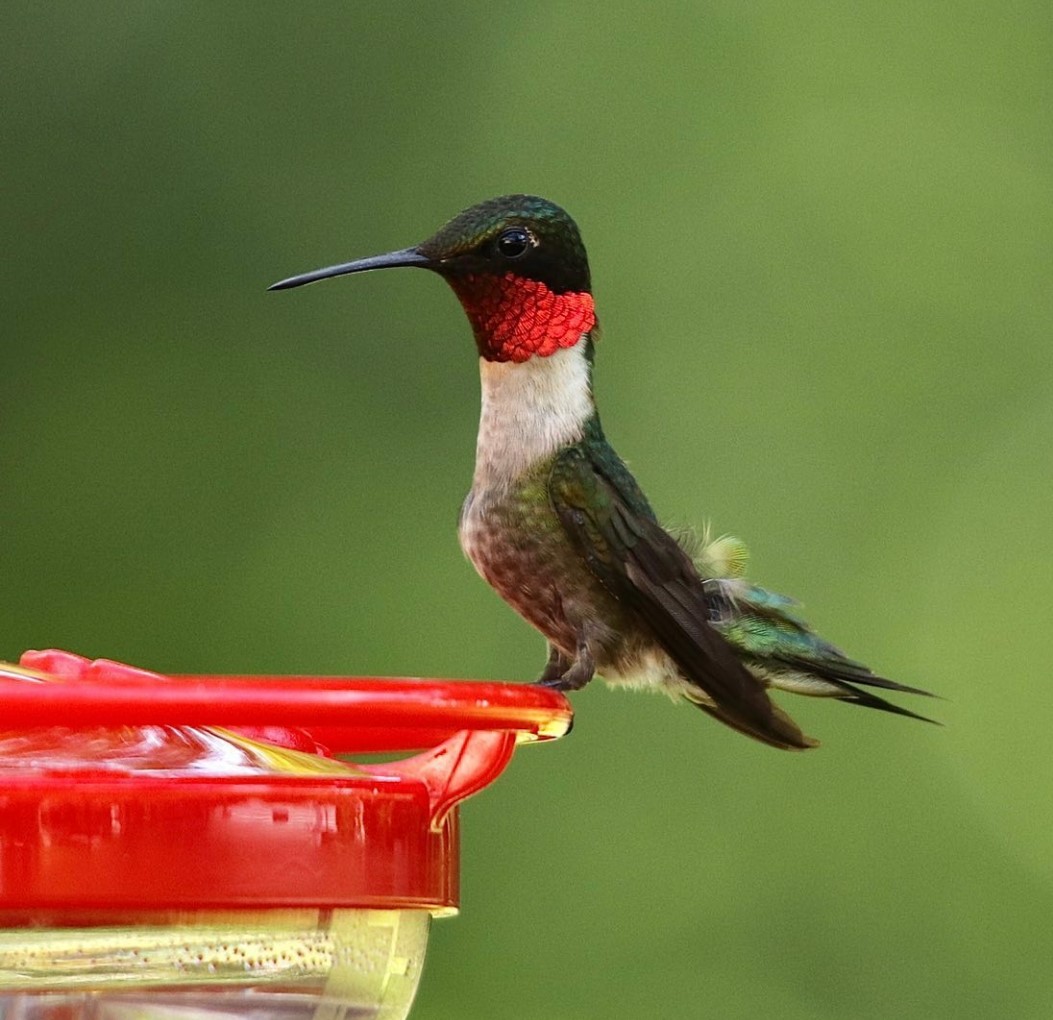This post contains affiliate links.
When do hummingbirds arrive in Florida?
Florida migrating hummingbirds begin arriving in early March on their journey north to their preferred nesting area, somewhere near their own birth. The last of Florida’s spring migrating hummingbirds are gone by April. While some Ruby-throated hummingbirds live in Florida year-round, others of that species prefer to migrate north.
This time frame is supported by the University of Florida.
Florida’s year-round Ruby-throated hummingbirds begin mating and nesting in April.
Migrating hummingbirds, including the migrating Ruby-throated hummingbirds, continue their way north into the eastern half of the United States all the way into Canada.
Beginning their northern journey from as far south as Panama or as close as Mexico, migrating hummingbirds arrive in Florida as early as the beginning of March but by April, all migrating hummingbirds are gone from Florida.
Some Florida hummingbird enthusiasts report seeing migrating hummingbirds in Florida as early as February.
The first migrating hummingbirds will be males followed by the females about a week later. The males arrive first to stake out his territory that he will defend as he tries to attract a female.
Keep your eyes out for the brightly colored gorget of the male hummingbirds, the females will look less bright and duller in color.
See my article: How to Identify a Hummingbird’s Gender in 4 Easy Steps
Hummingbirds start their spring migration from as far south as Panama and need to fly about 3,800 miles to reach the middle of Florida if they choose to follow the coast line.
Some choose to fly across the Gulf of Mexico.
Hummingbirds starting their journey from Mexico need to fly about 1,400 miles to reach the middle of Florida.
The only hummingbirds that live and nest in Florida are the Ruby-throated hummingbirds, all other hummingbirds seen in Florida are just passing through to their nesting destination.
Even though the Ruby-throated hummingbird lives and nests in Florida, some of them also will be just passing through Florida to their own personal nesting destination of choice.
According to the University of Florida, the Ruby-throated hummingbird’s breeding range extends from the Atlantic ocean eastward as far as Kansas and from central Florida northward into Canada by a couple of hundred miles.
The entire reason for northern hummingbird migration, much like salmon swimming upstream to their place of birth to lay eggs, is to return to the area where they were born to mate, build a nest, and raise a family.
Once the breeding grounds have been reached, the focus then turns to finding a partner with which to mate.
Each species of hummingbirds have their own unique mating dance ritual of courtship to attract a female. They perform perfectly choreographed dives and dance maneuvers to attract a flirty female.
See my article: Hummingbird Dance: 5 Interpretive Explanations
There is no penetration during the mating ritual as male hummingbirds do not have any external sexual organs.
The mating process only lasts for approximately 3-5 seconds while the cloacae (kloh-ay-see) of both hummingbirds are pressed together which is called a “Cloacal Kiss” (kloh-a-coal kiss).
After the Cloacal kiss the female must begin building her nest immediately. Female hummingbirds prefer building her nest in deciduous trees 10-20 feet off the ground in deciduous trees.
According to the University of Florida, nests are constructed of plant materials such as plant down, decorated with lichens, moss, and fine plant fibers. All of these resilient outdoor elements are held together with spider web silk, which acts like glue.
It will take her between 5 – 7 days to construct her nest. Nests are usually located and constructed over water.
See my article: Hummingbird Parents: (Mating to Nesting)
See my article: Baby Hummingbirds: (Egg to Fledgling)
Hummingbirds usually lay 2 eggs, on consecutive days, per brood.
Most hummingbirds have 2 broods per year, but depending on migration time and day length in their nesting destinations, some hummingbirds can have more than 2 broods per year.
Ruby-throated hummingbirds, which are the only nesting hummingbirds in Florida, on average usually have 2 broods per year. However, there are occasions where they are able to work in an additional brood for a total of three broods per year.
When should I put out hummingbird feeders in Florida?
Florida hummingbird enthusiasts should put out hummingbird feeders in the first couple of days in March to attract the earliest arriving migration hummingbirds.
Some Florida hummingbird admirers leave hummingbird feeders up all winter long to provide life-saving nectar to Florida’s year-round resident, the Ruby-throated hummingbird.
This selfless act also provides nectar to other migrating species unable to migrate because of injury or old age.
How long do hummingbirds stay in Florida?
Some Ruby-throated hummingbirds stay in Florida year-round. The first northern migrating hummingbirds arrive in Florida at the beginning of March and the last southern migrating hummingbirds in the fall to leave Florida are gone in October.
Florida’s year-round residents, the Ruby-throated hummingbirds, or hummingbirds too old or injured to migrate, will probably be the only hummingbirds Florida’s hummingbird enthusiasts will see during the winter. However, the University of Florida reports an occasional Black-chinned or Rufous hummingbird has been seen in the winter.
Hummingbirds have exceptional memories and will remember every flower or feeder they have visited on their spring migration and will return to those nectar sources on their return during the southern migration in the fall.
See my article: Hummingbird Adaptation and Remarkable Ability to Locate Food
As summer sets in, the number of hummingbirds that visit feeders will decrease. The only brave hummingbirds Floridians will see during the hot and humid summer months will be the year-round hummingbird residents.
When the obstacles of summer heat are difficult to manage and unbearable, finding ways to keep your hummingbirds happy and hydrated with cool nectar is crucial.
See my article: How to Help Hummingbirds in Hot Weather
See my article: How to Cool Hummingbird Nectar in Hot Weather
When do hummingbirds leave Florida?
Florida’s migrating hummingbirds begin leaving the state in September, flying south to their overwintering areas in Mexico and Central America. Migrating hummingbirds will all be gone from Florida by the end of October.
This elongated migration time frame ensures late straggling migrants have enough food available to fuel their bodies before making the long taxing migration south for the winter.
The only hummingbirds Floridians will see during the winter are the year-round Ruby-throated hummingbirds, on rare occasions a Black-chinned or Rufous hummingbird, and possibly some migrating hummingbirds that are too old or injured to migrate.
Hummingbird migration is triggered by circadian or daily internal clock and the circannual rhythm or yearly clock.
Changes in the weather, temperature, time of season, a decline in food supply, and shorter days with less sunlight are all factors that trigger and influence an individual’s hummingbird’s instinct to migrate.
As with spring migration, male hummingbirds are the first to begin the southern migration in the fall. The female migrating hummingbirds will begin their southern fall migration as soon as they have completed raising her offspring.
How long does it take a Florida hummingbird to migrate?
It takes a Florida hummingbird about 45 hours of flying at its average migrating flight speed of 30 mph to fly from Florida to the Mexican border 1,400 miles away. Some fly at a relaxed distance as slow as 1 hour a day, others can fly 500 miles non-stop in about 20 hours as some do while migrating across the Gulf of Mexico.
Hummingbirds do not migrate in flocks as do other birds; they migrate individually on their own personal time clock.
As migration approaches, hummingbirds routinely gain 25% to 50% of their body weight by consuming increased quantities of nectar from feeders and flowering plants as well as catching bugs in mid air for protein.
This increase in body fat helps fuel the hummingbird on its long migration journey.
Therefore, maintaining feeders is critical in order to maximize food consumption that nourishes and prepares their bodies for migration.
Expect to see a magnitude of hummingbird visitors to your feeders in Florida during fall migration beginning in September.
The hummingbirds that visited your feeders during spring migration will remember exactly where your feeder is located and will most likely revisit that same feeder during fall migration on their way to their overwintering area in Mexico and Central America.
See my article: Hummingbird Adaptation and Remarkable Ability to Locate Food
When to take down hummingbird feeders in Florida?
The best time to take down hummingbird feeders in Florida for the winter is mid-November or when there have been no consistent hummingbirds at the feeders for a couple of weeks. Feeders can be up all winter to feed Florida’s year-round residents and those migrating hummingbirds too old or injured to migrate.
The dilemma that every hummingbird enthusiast struggles with every year is leaving the feeders up all year or taking them down during the winter.
See my article: Should I Keep My Hummingbird Feeder Out During the Winter?
Hummingbird enthusiasts leaving feeders up all winter will provide welcomed nutrition for Florida’s year-round Ruby-throated hummingbird and life-saving nutrition for those too old or injured to migrate.
Taking hummingbird feeders down mid-winter could be fatal for migrating hummingbirds that are too old or injured to migrate and become dependent on the feeders for winter nutrition.
Where do Florida hummingbirds go in the winter?
Florida migrating hummingbirds travel south to over-winter in Mexico, Guatemala, Belize, Honduras, El Salvador, Nicaragua, Costa Rica, and Panama.
All hummingbirds have excellent memories and can remember every flower or feeder they have visited during migration and will return to those sites along their migration pathway year after year.
Some hummingbirds have been spotted returning to a feeder for a couple of years after the feeder was removed.
See my article: Hummingbird Adaptation and Remarkable Ability to Locate Food
Male Ruby-Throated Hummingbird
Taken: Oak Hill, Florida
Happy Hummingbird Watching!
Backyard Visitors participates in affiliate programs which compensate us for referring traffic.


